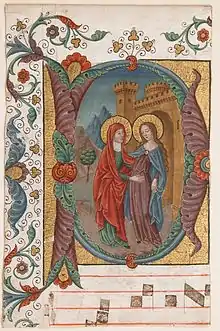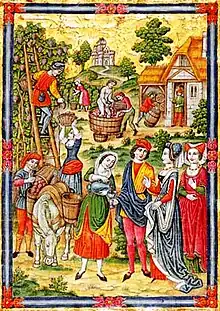Spanish Forger
The Spanish Forger (French: Le Faussaire espagnol) is the name given to an unidentified individual who, in the late 19th to early 20th century, created a large number of forgeries of medieval miniatures.


Technique and materials
The Spanish Forger's works were painted on vellum or parchment leaves of genuine medieval books, using either blank margins or scraping off the original writing. He also "completed" unfinished miniatures or added missing miniatures in medieval choir books. His works fooled many experts and collectors at the time and appear today in the collections of many museums and libraries. More than 200 forgeries have been identified.[1][2][3]
Nationality
As recently as 1930, the Forger was believed to be of Spanish origin. This is because one of his first identified forgeries was attributed as a genuine work by Jorge Inglés, a Spanish artist who was active during the 15th century.[4] However, when one considers the provenance of the Forger’s pieces along with many of the medieval collectible miniatures of the period, Paris was the center of purchasing, selling, and forging.[4] A number of his forged miniatures have been identified as copied, with modifications, from those published in several French books dating to the 1870s−1880s.[5]
Identification
The work of the Spanish Forger was first identified by Belle da Costa Greene who worked at the Pierpont Morgan Library. She was also the one who dubbed the artist the 'Spanish Forger'.[6]
His works were very deceptive when created, but over time it has been recognized that the faces of individuals in his pictures have "sugary expressions" inconsistent with genuine medieval illuminations.[7] Some of his miniatures have also been identified as forgeries because they are of secular scenes that would not have appeared in genuine medieval religious texts.[8] Additionally, many of the individuals in the Spanish Forger’s miniatures have a tilt to their heads that would not be present in authentic medieval works. In the "Knights of the Crusade" miniature, the bearded knight at the gate and the maiden in the bottom embellishment exhibit the classic head tilt. The facial expressions on most of the subjects in his miniatures are sweet and cloying, not pious and pensive as with true works. In legitimate medieval works, gold leaf was added first so that the paints would not be obscured by it. However, the Spanish Forger used gold leaf as a final touch, obscuring his paints and giving a lustrous appearance to his forgeries.[9]
Up to a certain point, most of the Spanish Forger’s miniatures had been identified by their unique stylistic characteristics. In 2009, Lucia Burgio, Robin Clark, and Richard Hark performed spectroscopic investigation, comprehensive analysis of pigments by Raman spectroscopy and X-ray fluorescence, upon five of the Spanish Forger’s miniatures in order to determine with scientific certainty that the forgeries were exactly that.[10] Use of the pigments ultramarine blue (first synthesized after 1828) and Scheele’s green (synthesized after 1775) were discovered, providing solid evidence that the Forger’s imitations were fabricated in post-medieval period.[10]
Exhibitions and collections
The Spanish Forger’s works were the subject of an exhibition at the Morgan Library in New York City in 1978, for which an extensive catalog was published.[11] His works are now themselves collected as forgeries, selling for several thousand dollars each.[12] He created more than 194 imitations that have been identified, which were purchased by multiple collectors of medieval art around the end of the 19th century and the beginning of the 20th century.[4]
In January 2009, it was announced that the Victoria and Albert Museum purposely acquired five examples of the Spanish Forger's work for their collection "for what it tells us about late 19th-century perceptions". The museum took the works in lieu of £20,000 ($US 30,000) of inheritance tax, equivalent to a value per work of about $6,000.[13] Another of the artist's paintings appeared on an episode of the Antiques Roadshow in 2014, being valued at around $4,000.[14]
See also
- Art forgery
- Ferdinand Charles François de Pape
Further reading
- "The Spanish Forger: Master of Manuscript Chicanery" in Thomas Coomans & Jan De Maeyer, eds., The Revival of Medieval Illumination: Nineteenth-Century Belgium Manuscripts and Illuminations from a European Perspective (Leuven, 2007), pp. 207–227. Catalog raisonné of works of the Spanish Forger.
References
- William Voelkle, assisted by Roger S. Wieck, The Spanish Forger, New York, Pierpont Morgan Library, 1978 (containing a catalog of known forgeries, with many images).
- "Spanish Forger miniatures in book at Yale". Brbl-net.library.yale.edu. Retrieved 2012-12-20.
- Auction results: 227 forgeries have been found.
- Wieck, William Voelkle; assisted by Roger S (1978). The Spanish forger. New York: Pierpont Morgan Library. ISBN 978-0875980652.
{{cite book}}: CS1 maint: multiple names: authors list (link) - "Manuscript Studies: Bibliography (Forgeries / bibliographic fraud)". Retrieved 28 March 2017.
- Backhouse, Janet (1968). "The 'Spanish Forger'". The British Museum Quarterly. 33 (1/2): 65–71. doi:10.2307/4423017. JSTOR 4423017.
- Otto Kurz, Fakes, New York,1948, p. 90.
- "Penn Special Collections-Schoenberg Exhibit Arts of the Page". Library.upenn.edu. 2012-08-02. Retrieved 2012-12-20.
- Backhouse, Janet (Autumn 1968). "The 'Spanish Forger'". The British Museum Quarterly. 33 (1/2): 65–71. doi:10.2307/4423017. JSTOR 4423017.
- Burgio, Lucia; Robin J. H. Clark; Richard R. Hark (July 17, 2009). "Spectroscopic investigation of modern pigments on purportedly medieval miniatures by the 'Spanish Forger'". Journal of Raman Spectroscopy. 40 (12): 2031–2036. doi:10.1002/jrs.2364.
- Willam Voelkle, supra.
- "Sale 103 results". 2006-02-08. Archived from the original on February 8, 2006. Retrieved 2012-12-20.
{{cite web}}: CS1 maint: unfit URL (link) - "US". Retrieved 28 March 2017.
- "Spanish Forger Painting | Antiques Roadshow". PBS. 2001-08-18. Retrieved 2017-03-28.
External links
- UCLA copy.
- Two images on Maggs Bros Ltd website, with high resolution magnification feature
- Copy at Dartmouth College
- Image with high resolution magnification feature